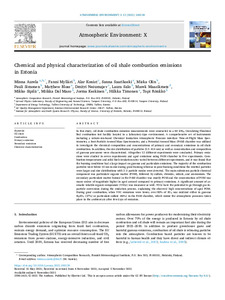Chemical and physical characterization of oil shale combustion emissions in Estonia
Aurela, Minna; Mylläri, Fanni; Konist, Alar; Saarikoski, Sanna; Olin, Miska; Simonen, Pauli; Bloss, Matthew; Nešumajev, Dmitri; Salo, Laura; Maasikmets, Marek; Sipilä, Mikko; Dal Maso, Miikka; Keskinen, Jorma; Timonen, Hilkka; Rönkkö, Topi (2021-12)
Aurela, Minna
Mylläri, Fanni
Konist, Alar
Saarikoski, Sanna
Olin, Miska
Simonen, Pauli
Bloss, Matthew
Nešumajev, Dmitri
Salo, Laura
Maasikmets, Marek
Sipilä, Mikko
Dal Maso, Miikka
Keskinen, Jorma
Timonen, Hilkka
Rönkkö, Topi
12 / 2021
100139
Julkaisun pysyvä osoite on
https://urn.fi/URN:NBN:fi:tuni-202112038890
https://urn.fi/URN:NBN:fi:tuni-202112038890
Kuvaus
Peer reviewed
Tiivistelmä
In this study, oil shale combustion emission measurements were conducted in a 60 kWth Circulating Fluidized Bed combustion test facility located in a laboratory-type environment. A comprehensive set of instruments including a nitrate-ion-based Chemical Ionization Atmospheric Pressure interface Time-of-Flight Mass Spectrometer, a Soot-Particle Aerosol Mass Spectrometer, and a Potential Aerosol Mass (PAM) chamber was utilized to investigate the chemical composition and concentrations of primary and secondary emissions in oil shale combustion. In addition, the size distribution of particles (2.5–414 nm) as well as concentration and composition of gaseous precursors were characterized. Altogether 12 different experiments were conducted. Primary emissions were studied in seven experiments and aged emissions using PAM chamber in five experiments. Combustion temperatures and solid fuel circulation rates varied between different experiments, and it was found that the burning conditions had a large impact on gaseous and particulate emissions. The majority of the combustion particles were below 10 nm in size during good burning whereas in poor burning conditions the emitted particles were larger and size distributions with 2–3 particle modes were detected. The main submicron particle chemical component was particulate organic matter (POM), followed by sulfate, chloride, nitrate, and ammonium. The secondary particulate matter formed in the PAM chamber was mostly POM and the concentration of POM was many orders of magnitude higher in aged aerosol compared to primary emissions. A significant amount of aromatic volatile organic compounds (VOCs) was measured as well. VOCs have the potential to go through gas-to-particle conversion during the oxidation process, explaining the observed high concentrations of aged POM. During good combustion, when VOC emissions were lower, over 80% of SO2 was oxidized either to gaseous H2SO4 (37%) or particulate sulfate (46%) in the PAM chamber, which mimic the atmospheric processes taken place in the ambient air after few days of emission.
Kokoelmat
- TUNICRIS-julkaisut [16983]
